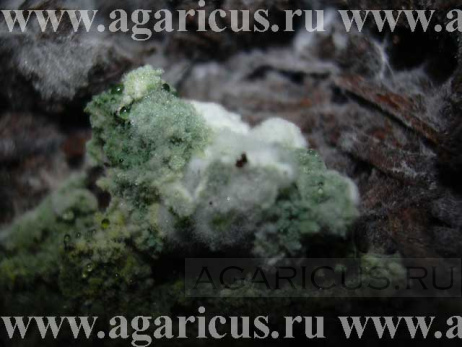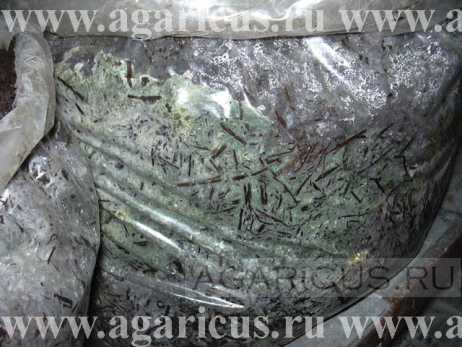The appearance of green mold on the compost
The presence of many kinds of green molds in the compost indicates an insufficient selectivity of the compost.
Breakdowns either in the fermentation process or in the process of pasteurization and compost conditioning and overly humid compost can lead to the appearance of green molds. Green molds grow especially fast on a substrate, where there are plenty of digestible carbon compounds. That is why the use of supplements, such as soybean flour, or flour made cotton seeds etc on compost that is nonselective or poorly grown with mycelium can lead to rather unpleasant results. The infection of the compost with green mold can be so severe that it completely chokes the mushroom mycelium growth from the spawning period.
Green mold at magnification
A bag of compost, affected with green mold
In order to avoid these problems, you have to be careful from the very first step of composting. It’s unadvisable to use low-quality raw materials for compost preparation: moldy straw or old poultry manure.
Watch the pH level of substrate in the process of its preparation. Some species of Trichoderma grow well at a pH level lower than 6 and especially at a low level of nitrogen. The ratio of carbon and nitrogen of 22 or 23:1 is favorable for the growth of trichoderma in the compost (a normal ratio is 15:1). Use the required amount of gypsum, according to the formula of compost preparation.
Not all kinds of green molds affect the mushroom yield the same way. For example, among the many trichoderma strains, there are those which grow best in the presence of mushroom mycelium and that way, they cause the greatest problems, when they get in the compost at the same time as the mycelium. In the closed system of growing mycelium, for example, in bags or blocks packed in a film, where temperature is usually high and these molds are especially dangerous.
The control of trichoderma strains is much harder. On farms, where the disease is already present, the infection of new batches of compost mostly happens through the mold’s spores, that are spread everywhere by wind, the movement of personnel, by insects, mites and small animals such as rats and mice. That is why the main goal is to exclude the possibility of a new infection. This can be achieved by only focusing of hygiene and on a program similar to the one used to control mushroom virus diseases. It’s important to avoid infection of compost during the time from cooling to the first week of spawn run.
Here it’s important to:
Breakdowns either in the fermentation process or in the process of pasteurization and compost conditioning and overly humid compost can lead to the appearance of green molds. Green molds grow especially fast on a substrate, where there are plenty of digestible carbon compounds. That is why the use of supplements, such as soybean flour, or flour made cotton seeds etc on compost that is nonselective or poorly grown with mycelium can lead to rather unpleasant results. The infection of the compost with green mold can be so severe that it completely chokes the mushroom mycelium growth from the spawning period.
Green mold at magnification
A bag of compost, affected with green mold
In order to avoid these problems, you have to be careful from the very first step of composting. It’s unadvisable to use low-quality raw materials for compost preparation: moldy straw or old poultry manure.
Watch the pH level of substrate in the process of its preparation. Some species of Trichoderma grow well at a pH level lower than 6 and especially at a low level of nitrogen. The ratio of carbon and nitrogen of 22 or 23:1 is favorable for the growth of trichoderma in the compost (a normal ratio is 15:1). Use the required amount of gypsum, according to the formula of compost preparation.
Not all kinds of green molds affect the mushroom yield the same way. For example, among the many trichoderma strains, there are those which grow best in the presence of mushroom mycelium and that way, they cause the greatest problems, when they get in the compost at the same time as the mycelium. In the closed system of growing mycelium, for example, in bags or blocks packed in a film, where temperature is usually high and these molds are especially dangerous.
The control of trichoderma strains is much harder. On farms, where the disease is already present, the infection of new batches of compost mostly happens through the mold’s spores, that are spread everywhere by wind, the movement of personnel, by insects, mites and small animals such as rats and mice. That is why the main goal is to exclude the possibility of a new infection. This can be achieved by only focusing of hygiene and on a program similar to the one used to control mushroom virus diseases. It’s important to avoid infection of compost during the time from cooling to the first week of spawn run.
Here it’s important to:
- before filling and spawning, the prepared clean machinery and equipment must be treated with 2% formalin solution;
- all the work with mycelium must be carried out in clean clothes and with clean hands;
- filter the air, that is supplied into pasteurization and spawn run rooms;
- regulate and control the movement of personnel in «clean» and «dirty» zones;
- control rodents and insects;
- get rid of areas of compost affected by red pepper mites, by strewing them with salt or burning them;
- after spawning, cover the compost with a paper, sprinkling it with a 2% formalin solution every 3-4 days;
- steam the growing rooms, containers and the used tools and equipment after each cultivation cycle at a temperature of 70°C for an hour;
- regularly disinfect all buildings and concrete surfaces in the farm and outside it;
- the clothes of pickers and other personnel, that work in the growing rooms, must be washed in washing machines daily, or steamed in a drying cabinet for 30 minutes at a maximal temperature.



Lko:
Saheb hamare mushroom dry bable se pura form doob chuka hai ismein Ham Kya Karen Sahab Koi upay Ho to...
Production of Compost, Personal opinion (part 3). Wet...Abimbola Olaniyi-Balogun, Lagos Nigeria:
Hello there, I made mushroom compost using the long composting method. I used wet chicken manure, fresh...
Mushrooms in KazahstanZagreb, Croatia:
My name is Zlatko Vidmar.
Without chicken manure compost? Yes, it's possible...I am in modern mushroom growing over 40 years.
I see your farm and if...
nanyuki:
my email is samuelnjogo@gmail.com
Without chicken manure compost? Yes, it's possible...nanyuki:
i want to learn like a child on compost making for mushroom
Mushrooms in KazahstanVELLORE TAMILNADU INDIA:
SUITABLE JOBS – MUSHROOMS GROWER / COMPOST / SPAWN OR RELAVANT FIELDS
Without chicken manure compost? Yes, it's possible...Dear Hiring Manager...
Patna:
PLEASE SEND YOUR FORMULA without-chicken-manure-compost
watering first flush mushroomswasil, Malaysia:
i suggest you not to water on mush just maintain the good humidity if you not have any auto system for...
Compost Production. Personal opinion (Part 2)NARENDER SEHRAWAT, FARIDABAD NCR:
COMMON PROBLEM IN PHASE 1 BUNKAR IS THE UNBALANCED TEMERATURE, IT STARTS FROM 50-55 DEGREES TO 78-82...
Without chicken manure compost? Yes, it's possible...Hannes, Plettenberg Bay, South Africa:
Can you give me more details on compost without chicken manure for mushroom growing, what alternatives...